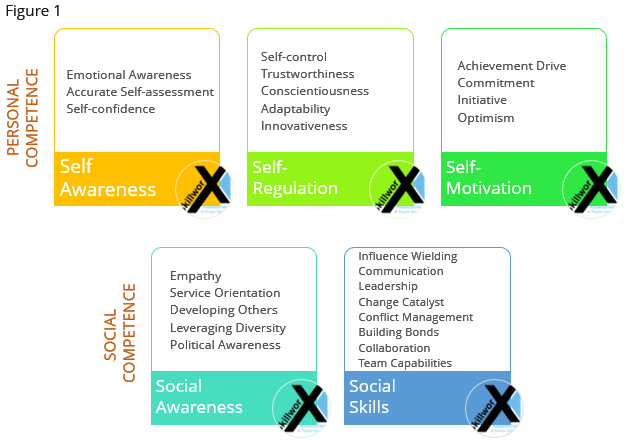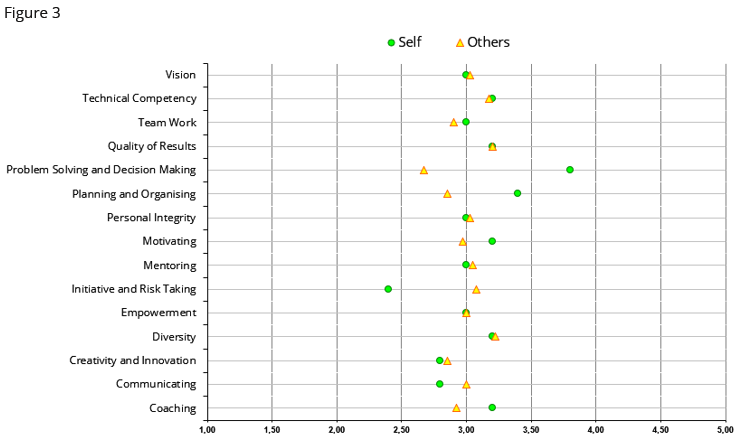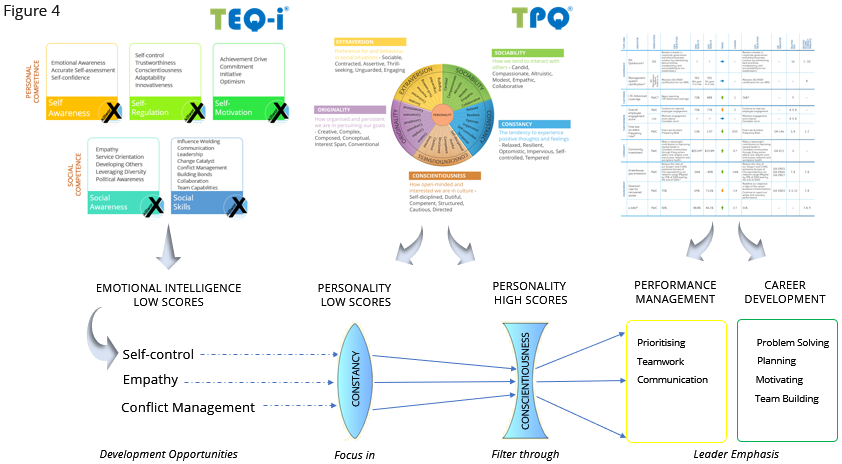Using Emotional Intelligence when Coaching or Mentoring

As a coach or mentor, you have likely come across the concept of emotional intelligence in your day to day practice. If this is the case, you would then have noticed that your colleagues are also increasingly appreciating the fact that emotional intelligence has application for both personal development as well as effective functioning in the workplace.
There are a range of models of emotional intelligence. My model includes the ability to monitor your own and others’ feelings and emotions, differentiate among them, and then use this information to manage your thoughts and actions (Figure 1). People that have high levels of emotional intelligence typically display strong emotional competencies such as the ability to manage relationships, navigate social networks, influence and inspire others. And, their ability to display sureness about their self-worth and capabilities make them comfortable with and open to novel ideas as well as persistent in pursuing goals despite facing obstacles and setbacks.
In today’s workplace, emotional intelligence has become a highly important factor for success, influencing productivity, efficiency, and team collaboration. Whether you are transferring specific skills and knowledge to someone or looking to mentor a leader to that next aspirational level, leveraging a person’s emotional intelligence strengths is key.
Why does Emotional Intelligence matter?
Because, being able to handle frustration, control our emotions, and get along with other people (emotional competence) matters much more than IQ and Technical Skills combined. We’re all very aware of the narcissistic bully that, given any other context, would amount to very little but for the fact that they wield the power through either title or ownership. Now, compound that with low levels of emotional intelligence? If only for this reason, the commitment to identify and understand a client’s emotional competence should be a priority.
People that lack in EI find themselves constantly strained in the workplace. Low levels of personal or social competence, will inevitably complicate the way people function at work or life in general. For example, low levels of empathy are sure to derail a person’s ability to lead a team or effectively manage relationships. Equally, an inability to sense the way others are feeling or to appreciate how things look from someone else’s perspective will seriously compromise one’s ability to function in a management role.

As a coach, you can probably bet on one of your clients going through a performance management process because of “cultural” insensitivity.
Here again it’s a lack of political awareness that has the serious consequence of limiting the person’s ability to read a group’s emotional currents and sensitively deal with the complexity of multiple viewpoints and socio-cultural norms. While deficiencies like these are debilitating, with proper coaching or mentoring, a vested leader could be helped to develop the requisite competencies like political awareness and leveraging diversity, among others.
Is it because “I just don’t have what it takes”?
Emotional Intelligence is a collection of various competencies and related facets. There is no equivalence to IQ. The use of “Intelligence” is a misnomer and an unfortunate one at that. It does however serve to frame the idea of what “intuitive smartness” means in the context of Social and Personal leadership. Unlike personality, EI is an aggregation of different competencies not traits. For this reason, the competencies and their related facets are used by coaches or mentors as a collection of behaviours and not some monolithic “thing”. Together, however, these do produce an integrated emotional intelligence picture. When we aggregate all these competencies into an overall EI score, it is no more than a standardised raw score set at a mid-point of 100, giving it the look and feel of the traditional IQ scores we are all familiar with. This is where the similarity starts and ends.
My emotional intelligence framework provides three Personal Competencies (self-awareness, self-regulation, and self-motivation) and two Social Competencies (social awareness, and social skills) with 28 underlying facets. These provide a plethora of EI information for either coaching or mentoring of leaders as well as people in non-work contexts. While there are a few models that will typically prioritise certain competencies over others, any good EI report should be able to intuitively provide you with a clear indication of what the flags are and which strong EI competencies the coach could use as part of any intervention process (See Figure 1).
As a coach, while you will need the competency-based emotional intelligence tool to develop or grow EI competencies in the client it is equally important to understand the way in which your client approaches challenges or opportunities for growth. Understanding what the psychological dimensions are that make up the client’s personality profile will help coaches or mentors understand what the root causes are to solutions. The EI typically nails down the gaps and opportunities for leadership performance development or growth while the Personality assessment defines the optimal way to navigate the client through the process. Again, there are a number of personality assessments available. Mine (TPQ) is based on the Five-Factor model – a concept that it is founded on the idea that five main factors are necessary and sufficient for broadly describing human personality (Figure 2).

Coaches or mentors alike will find that the inclusion of a personality assessment helps to highlight how the client personally experiences and reacts to the world around them. This in a sense lays down the “rails” to work on as one works toward identifying those EI target areas to strengthen or develop. While it is true that emotional intelligence is a collection of acquired competencies, it is important to appreciate that these skills are being learnt by an individual with a very distinct and unique personality wired and nurtured from birth.
This has to be a consideration when navigating our coaching and mentoring process. At the minimum it optimises how effective the behaviour transformation or personal development will be.
It’s a matter of perception
There is a view that using a 360 degree-type EI tool will help contextualise the client’s self-report by providing external context. I am not completely convinced of this approach’s efficacy. EI assessments are inherently self-reporting mechanisms. This means that the moment we have other input into the same set of items we confound the very end we’re trying to get to – defining the individual’s self-reported emotional intelligence state. That, and only that, should be the departure point for any developmental or performance management discussion. Any other 360-degree input should be based on functional or organisational leadership criteria and used in conjunction with the individual’s personal emotional intelligence and personality information, when crafting any coaching or mentoring plan (Figure 3).

Coaching and mentoring are processes. While they may have short and long term deliverables respectively, they still need the diligence of process and time to firstly establish how the client functions as a human being (personality), what social and personal competency point-in-time profile they have (emotional intelligence), and only then, how it relates to the way they perceive their leadership performance in relation to their peers from an organisational perspective (T360 degree leadership).
Essentially, coaching or mentoring to drive in-organisational functioning is primarily about the individual first and then how we optimise the human within the structure of an organisation. EI is not synonymous with leadership or management. Leadership is a consequence of learned behaviours underpinned by a specific personality profile. For example, a director low on Constancy (the tendency to experience positive thoughts and feelings) may need more than just guidance on Emotional Intelligence gaps in Self-control, Empathy, or Political Awareness since she has a personality that defaults to a more tense, defeatist, pessimistic, permeable, impulsive, and aggressive position when either leading or being led. So, simply focusing in on the EI behavioural issues without understanding your client’s primary temperament when dealing with tough discussions may be counter-intuitive.
Let’s bring this together
As you’re aware, the end-game of coaching or mentoring is a functional, happy human being. Period. It’s the consequences of that agenda that benefit the organisation, friends, family and society. As a coach or mentor, try to keep that front and centre. Specifically, when your client is part of an organisation’s agenda. No amount of coercion or persuasion will substitute for a willing and vested client. Every single instrument, tool, and model will fail without the authentic and genuine commitment of the client.
That being said, when exploring emotional intelligence when coaching, the process needs to be linked to a specific outcome. An inter-personal (team or leadership) outcome will distil low EI competencies, focus (moderate) these through the restraints of the low personality facets, and then optimise the development of the competencies (filter through) using the stronger personality facets. Figure 4 illustrates this process. Here the outcome is to coach the client in areas of prioritising, teamwork, and communication and to mentor the client in areas of problem solving, planning, motivating, and team building.
In this example, the assumption would be that all the high EI competencies are available to contribute to the achievement of the outcome. The low competencies, on the other hand, need to be identified and moderated using the strengths and weaknesses of the client’s personality profile. This means that the strategies to address the low EI competencies need to take into consideration the Client’s low Constancy levels (more tense, defeatist, pessimistic, permeable, impulsive, and aggressive) and how these can be mitigated and then optimised using the Client’s high Conscientiousness levels (methodical, well organised, and dutiful). This then frames the coaching or mentoring strategy to address the short-term prioritising, team-work, and communication performance / goal aspects and the more long-term, problem-solving, planning, motivating, and team building support and guidance development aspects.

Figure 5 lays out, in much the same way, how the same mechanisms apply to optimising the way your Client functions in the workplace in a way that narrows the gap between how they perceive themselves in relation to the way other stakeholders in the organisation perceive them.

As with the inter-personal outcome, the EI and Personality mechanism for an organisational outcome remain exactly the same. The difference is simply that the coaching or mentoring strategy is focused on behaviour change that facilitates moderating the perception gaps between the Client and others.
These gaps between self and others ratings identify specific areas for growth and provide the reference point for which competencies need developing to address the observed leadership gaps. Here, the focus hinges on optimising the Client’s ability to function within the organisation – a structured environment outside the Client’s frame of control. Here the outcome is not simply to elevate the individual’s performance or development, but to position the individual in a way that optimises integration in the workplace or society.
Charity begins at home
Because emotional intelligence is about the capacity to be aware of, control, and express your emotions, and to handle interpersonal relationships sensibly and compassionately it makes sense for you as a coach to take the time to develop these competencies. Good coaches and mentors intuitively apply EI competencies. They elicit clear, well-defined and emotionally engaging goals by applying high levels of conscientiousness. They are able to sense their client’s feelings and perspectives through empathy and emotional awareness. They are able to actively listen and intuit through their ability to build bonds and develop others.
While an effective way to introspect is to partner with a fellow coach to help you debrief your EI assessment, there is no reason why you as a coach cannot do this on your own. Navigate through all the competency scores above 77.5 and below 115 and use them to beef up your understanding of your emotions and how it could impact you and your coaching approach. Competency scores at this level is where most folks would normally be distributed. Competency scores of 115 and above are really strong. These are emotional competencies you should capitalise on when coaching or mentoring. Competencies at this level are typically intuitive. For example, if you had a social awareness score of 115 or above, you would more than likely instinctively sense how others are feeling, what they need, and how to read their emotional state. These are great qualities to have as a coach. Conversely, scores at 77.5 or below needs a concerted development focus. Consider an optimism (self-motivation facet) score of 77.5 or below. This should be a flag for any coach or mentor as it suggests a possible problem in pursuing goals when confronted by obstacles and setbacks. Here self-reflection and possibly journaling the importance of not getting hung up on one thing, the importance of using positive affirmations, surrounding oneself with positive people, are some simple mechanisms of shifting the cycle of pessimism.
The key take-away here is not to belabour the low EI competency scores but to ensure that, as a coach, you know what they are and have a plan to develop them. Essentially, to understand one’s strengths and limitations and to use the EI strengths to overcome any inertia typically associated with the low competencies.
It’s usually human error
Clients will have a range of reasons and expectations for needing coaching or mentoring. Some may be performance related while others, personal growth. You may find clients with really strong personal competence profiles but lacking considerably on the social competence side. These are typically the high-flying individual contributors that excel and shine as long as they are working to their own drumbeat and driving their individual agendas. Inevitably, these are the square plugs that well-meaning leaders try to squeeze into round holes by promoting them into positions responsible for managing teams. So, not surprisingly, one performance cycle later you’re called in as a coach. And in short order, these considerations start keeping you up at night:
How do I make someone, that obviously hates being confined to structure and consider others when making decisions, take the time to nurture instrumental relationships?
In what way do I sell in the idea to a reluctant participant that persuasion is the solution as opposed to dragging everyone along against their will?
How do I shift their thinking to understand that taking the time to sense what others need is half the battle won when trying to get your way?
And the list goes on. All these complex questions are usually symptomatic of an awareness that the human condition is not only complex but uniquely individualised and that figuring out where to start is not as easy as it appears. Without minimising these concerns, good coaches and mentors understand the importance of not only asking the right questions but, always understanding that there’s an individual at the other end of it. Keep in mind that emotional intelligence competencies are learnable skills and not personality traits.
If we accurately identify them, and we have a willing client as a participant, we can comfortably chart a way forward and effectively strengthen their requisite emotional intelligence competencies.
So, as daunting as all of this may seem, it’s really as simple as eating an elephant – one bite at a time. Remember, it’s all about the person. So, firstly assess their emotional intelligence (e.g. TEQ-i) and then figure out how they, as a personality (e.g. TPQ), deal with things. Then, in the most authentic way, help your client work things out for themselves, show them where they went wrong and, more importantly, where they’re going right.
For more information or assistance, please contact Gary Townsend at Skillworx Africa (Pty) Ltd, mobile 0824915392, gary@skillworxafrica.com. Or feel free to browse our website on www.skillworxafrica.com.